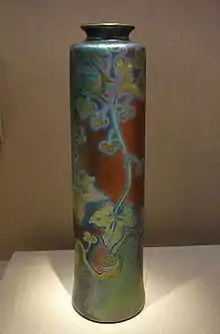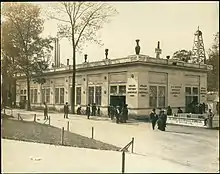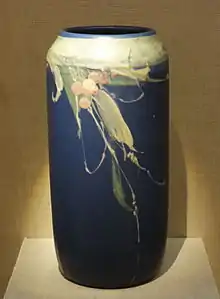Weller Pottery
In 1872, Samuel A. Weller founded Weller Pottery in Fultonham, Ohio, United States. Originally, his business consisted of a small cabin and one beehive kiln, and Weller produced flower pots, bowls, crocks, and vases.[1] By 1905, Weller Pottery was the largest pottery in the country. It mass-produced art pottery until about 1920, and it produced commercial lines until the pottery closed in 1948.
| Type | Corporation |
|---|---|
| Founded | 1872 in Fultonham, Ohio, United States |
| Founder | Samuel A. Weller |
| Defunct | 1948 |
| Headquarters | |
| Products | Vases, pots, ceramic tile, cuspidors, bowls, crocks |

Early period, 1872−1910
In 1872, when Samuel Augustus Weller (1851−1925) was 21, he established and operated a one-man pottery in Fultonham in Muskingum County, Ohio.[2] Between 1882−1890, he had expanded to Zanesville, with a factory on Pierce Street along the river. In 1893 he saw William Long's Lonhuda ware at the Chicago World's Fair, and Long joined Weller to produce this faience-glazed pottery line.[3] When Long left Weller's employ after less than a year, Weller renamed the faience line Louwelsa after his daughter Louisa, who had been born in 1896.


From 1895−1904, Charles Babcock Upjohn was Weller's head designer, developing the Dickensware I, Dickensware II, Eocean and Corleone lines.[1]
By 1897, Henry Schmidt designed Weller's Turada line, the first "squeeze-bag" pottery line in the Ohio valley.[4] Decorators used squeeze-bags like cake decorators, squeezing the paint onto the ceramic rather than painting it on with brushes.
From 1902−1907, Jacques Sicard and Henri Gellie worked at Weller's pottery to develop a metallic glaze, which had been introduced by Clement Massier in France by 1889, as Reflets Metalliques. The Sicardo line went into production in the fall of 1903, but the process was difficult, and only about 30% of the finished pots were marketable.[1][5]
In this same period, between 1902 and 1905, Weller had become the world's largest pottery and mass-producer of art pottery.[1] In 1903 and 1904, Frederick Hurten Rhead worked for a short time at Weller Pottery, developing Jap Birdimal line in 1904. He left in 1904 to become Roseville Pottery's first art director, and later designed the very popular Fiesta line for Homer Laughlin China Company.
At the St. Louis Exposition in 1904, Weller had huge display, including a 7.5 ft (2.3 m) vase, and a working studio, complete with a kiln.[1]
In 1908, Rudolph Lorber developed Dechiwo, which led to Burntwood, Claywood, and other similar lines.[1]
Early Weller art ware lines
.jpg.webp)
%252C_1902%E2%80%9307_(CH_18802897).jpg.webp)
Louwelsa 1896–1924
Dickensware I 1897–1898
Dickensware II 1900–1905
Dickensware III 1903–1904
Turada 1897–1898
Aurelian 1898–1910
Eocean 1898–1918
Sicard 1902–1907
Jap Birdimal 1903
Fru Russet 1904
Floretta 1904
Hunter 1904
Matt Floretta 1904
Perfecto 1904
Dresden 1905–1910
Etna 1906
Burntwood and Claywood 1910
Middle period, 1910−1932
From 1916−1929, Rudolph Lorber developed Brighton birds, Muskota, Woodcraft, Forest, Glendale and other great naturalistic lines, ending with Coppertone in 1929.[4] In 1917, Weller had introduced the family of Hudson lines. In this same period, Dorothy England Laughead created Silvertone, Chase, and the Garden Animals.[4] John Lessell headed the decorating department from 1920−1924, developing luster−glaze lines including LaSa, Marengo, Cloudburst, Lamar, and others.[4]
On July 1, 1922, Weller Pottery incorporated as "S.A. Weller, Inc."[4]
Samuel Augustus Weller died on October 4, 1925.[6] His nephew Harry Weller became president from 1925−1932, introducing continuous kiln operation. He consolidated the Weller plants in 1931 due to depression era economics, and died in auto crash in 1932. From 1930−1932, the last freehand decorated lines introduced at Weller were Stellar, Geode, Cretone, Raceme, and Bonito.[4]
Middle period art ware and commercial lines
Cameo Jewel 1910
Souevo 1910
Camelot 1913
Clinton Ivory−before 1914
Roma 1914−late 1920s
Muskota 1915
Teakwood 1915
Athens 1915
Blue Drapery 1915
Brighton 1915
Copra 1915
Creamware 1915
Fairfield 1915
Orris 1915
Baldin 1915–1920
Flemish mid teens−1928
Forrest mid teens−1928
Jewell approx. 1916
Dupont late teens
Rosemont late teens−late 1920s
Zona 1920
Late period, 1932−1948
From 1932−1933, Sam Weller's son-in-law Frederic Grant was president for one year. When Grant divorced from Weller's daughter Ethel, Weller's other son-in-law, Irvin Smith, (married to Louise) became president from 1933−1937.[4]
By 1935, freehand decoration had ended at Weller Pottery; from 1935−1948, Weller produced simplified embossed lines.[4] From 1937−1948, Walter Hughes, a ceramic engineer and former employee at American Encaustic Tiling Company, was Weller Pottery's last president. During 1947−1948, Essex Wire Corporation acquired a controlling share in Weller, closing the pottery in 1948.[4]
Late period commercial ware
Woodcraft 1920−1933
Hudson 1920's−mid 1930s
Voile early 1920s−1938
Alvin 1928
Glendale through the 1920s
Silvertone through the 1920s
See also
References
- Huxford, Sharon; Huxford, Bob (1979). The Collector's Encyclopedia of Weller Pottery. Paducah, Kentucky: Collector Books. pp. 7–22.
- "Remains of S.A. Weller arrive from Washington early Monday afternoon". The Zanesville Signal. October 5, 1925.
- "Weller, Fultonham & Zanesville Ohio". wisconsinpottery.org. Wisconsin Pottery Association. 2002. Retrieved December 6, 2015.
- "Weller Pottery - Fultonham & Zanesville Ohio - Timeline". wisconsinpottery.org. 2001. Retrieved December 12, 2015.
- "Weller, Fultonham & Zanesville Ohio - Weller and Company". wisconsinpottery.org. 2002. Retrieved December 13, 2015.
- "Weller funeral to be Wednesday at family home". Zanesville Signal. October 6, 2015.